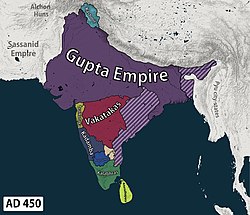
Back Traikutaka Catalan ત્રૈકુટક વંશ Gujarati त्रैकुटक वंश Nepali Traikutaka dynasty SIMPLE திரிகூடக வம்சம் Tamil
Traikutaka dynasty | |||||||||||
|---|---|---|---|---|---|---|---|---|---|---|---|
| c. 388 CE–c. 456 CE | |||||||||||
 Map of the territory of the Traikutakas (in yellow), along with their contemporaries, especially the Kadambas, the Vakatakas and the Gupta Empire. | |||||||||||
| Common languages | Sanskrit Prakrit | ||||||||||
| Religion | Hinduism | ||||||||||
| History | |||||||||||
• Established | c. 388 CE | ||||||||||
• Disestablished | c. 456 CE | ||||||||||
| |||||||||||
| History of Gujarat |
|---|
The Traikutakas were a dynasty of Indian kings who ruled between 388 and 456. The name "Traikutakas" seems to be derived from the words for a three-peaked mountain ("Tri-kuta"). The Traikutakas are mentioned in Kalidasa's Raghuvamsa, in which they are located in the area of northern Konkan. The dominions of the Traikutakas further included Aparanta and northern Maharashtra.[2]
The coins of the Traikutaras are found extensively in southern Gujarat, and southern Maharashtra beyond the Ghats. Their design is very close to that of the Western Satraps, from which they probably inherited some territories, and traces of the obverse legend with Greek letters can still be seen.[3]
- ^ Rapson, E. J. (Edward James) (1908). Catalogue of the coins of the Andhra dynasty, the Western Ksatrapas, the Traikutaka dynasty, and the "Bodhi" dynasty. London : Printed by order of the Trustees. p. 198.
- ^ Rapson p.clxxxv.
- ^ Rapson, p.cixxiv.
![Silver coin of king Dahrasena. Obv: Bust of king. Rev: Chaitya and star.Brahmi inscription: "The glorious king Dahrasena, foremost follower of Vishnu, and son of king Indradatta".[1] of Traikutaka dynasty](http://upload.wikimedia.org/wikipedia/commons/thumb/3/3c/Dharasena%2C_Traikutaka_Dynasty.jpg/270px-Dharasena%2C_Traikutaka_Dynasty.jpg)